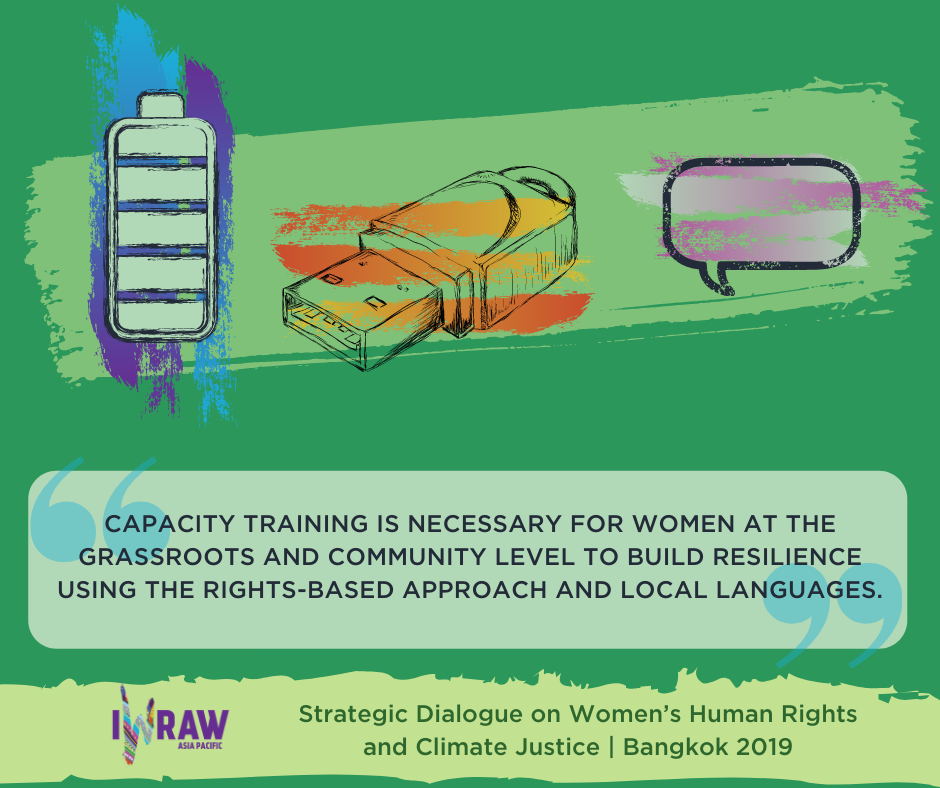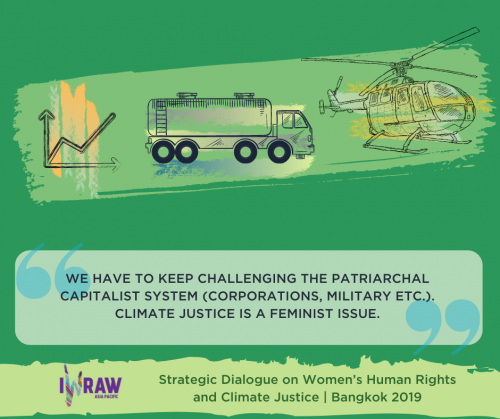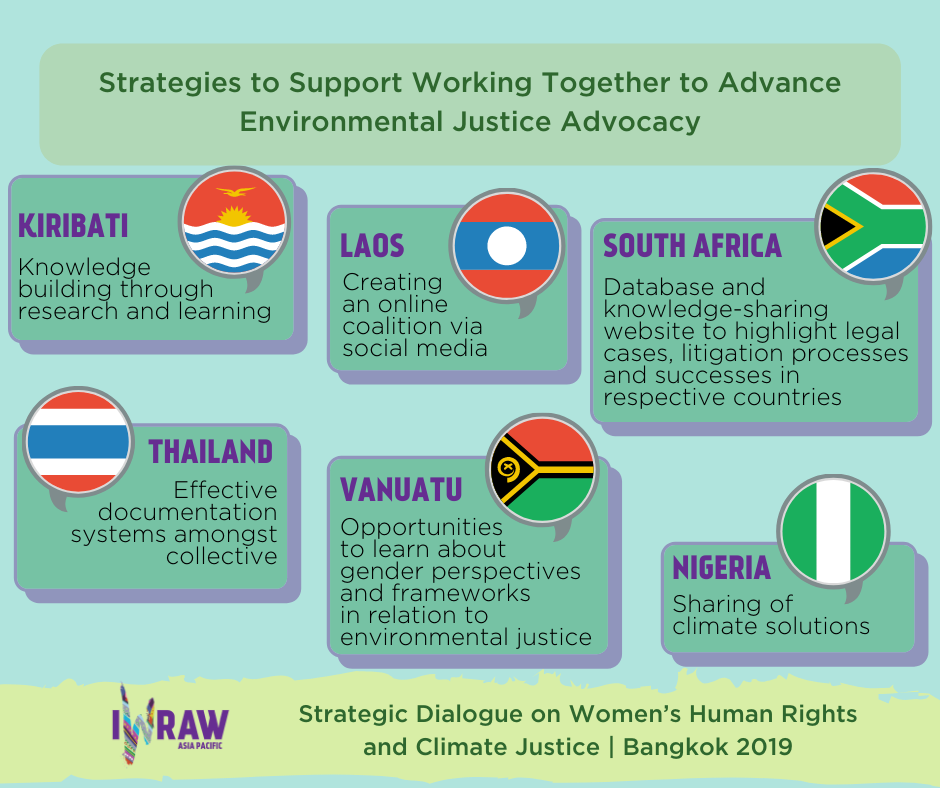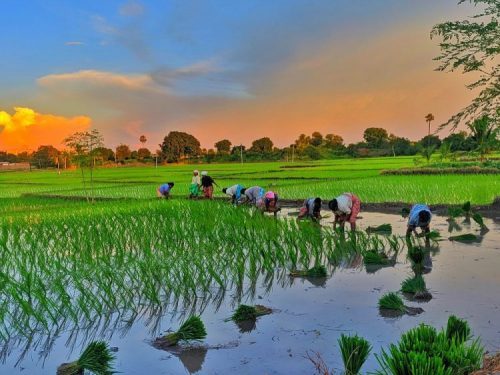
Photo by Prahlad Inala on Unsplash
In recognising the interrelation of environmental issues and social and political issues, IWRAW Asia Pacific aims to take an intersectional approach to confront institutional patriarchy, in order to protect the communities and livelihoods of those affected by environmental and climate change; ensure accountability of economic actions by governments and corporations, implement domestic climate measures and procedures, and centre the rights and leadership of women and marginalised communities. In 2018, the CEDAW Committee published General Recommendation No. 37 on gender-related dimensions of disaster risk reduction in the context of climate change. IWRAW AP intends to use the General Recommendation in our work as a basis for our advocacy towards achieving environmental and climate justice in the CEDAW space.
In 2019, IWRAW AP introduced Environmental Justice as one of our five priority programme areas, to support and amplify the feminist perspectives of women environmental defenders and other marginalised groups of women impacted by environmental degradation and climate change, in relevant policy and movement spaces, and build organisational knowledge in this area.
A two-day Strategic Dialogue on Women’s Human Rights and Climate Justice was convened by IWRAW AP in November 2019 to create an alternative space for engagement of activists representing different Global South regions (Asia, Pacific, Africa, Caribbean, Latin America). The Strategic Dialogue aimed to ensure the mutual exchange of experiences and solutions among the activists and to encourage capacity building and collaboration on key issues affecting their livelihoods and communities.
Context and Barriers
The climate crisis is complex, touching all areas, hence understanding what it is and how it impacts communities differently is the first step. Natural disasters often exacerbate other social issues, for example gender-based violence, inequalities in healthcare access and mental health issues, and migration. Documenting and reporting is a key part of the solution to ensure the accountability of policy makers and mandate holders. In some countries, groups with the support of litigators have filed legal cases highlighting issues affecting vulnerable people and groups. Indigenous groups are forced to defend their sacred lands from constructions of dams in Latin America, and encounter language barriers to communicating their issues in major participation processes. In Guatemala, an indigenous community fought for and proposed possible solutions for water management, and the installation of micro-turbines for energy, as a way of prohibiting the construction of dams. Ocean grabbing, which is part of the privatisation of natural resources, severely impacts the food security of many countries. In some countries, agricultural land areas are being converted into panel farms, diverting capital from small farmers. Illegal logging has become a big component of corruption in the Pacific. In Kenya and other African countries, mothers are tackling issues of hunger and malnutrition in their communities. Genetically modified organisms and other technology-based solutions introduced by international corporations are seen as causing a major issue for some communities. With the blue economy being viewed as a false solution to climate change, these activists believe that there is a need for international climate frameworks and organisations to ensure not only the understanding of key climate concepts but the incorporation of a gender and intersectional human rights approach which places marginalised people and groups at the centre of their action. This is necessary to account for the multiple forms of discrimination faced by marginalised groups, including indigenous people, persons with disabilities, the LGBTIQ community, displaced people, and others.
Global feminist research increasingly highlights how climate change and environmental degradation exacerbate existing social inequalities. However, the narratives of those most impacted by such realities continue to be marginalised within policy frameworks and policy spaces. Recent developments have seen attempts to strengthen linkages between the work of the global environmental justice movement and the human rights movement, including indigenous groups and the women’s rights and labour rights movements. Climate change is an urgent issue globally and a priority for feminists and women environmental defenders, particularly in the Global South.
Althoug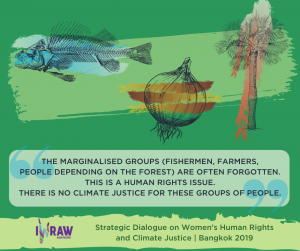 h women and other marginalised groups bear the brunt of the issues, ranging from natural disasters and land and ocean grabbing to the negative impacts of international corporations and corrupt governments, these groups are left uninformed and unequipped to combat environmental and climate events, with issues such as displacement and food security profusely affecting individuals and families. In reality, the human rights spaces and frameworks that different groups and movements occupy and employ remain siloed. IWRAW AP recognises the gap between the environmental justice movement and state accountability, and is well positioned to contribute to the women’s rights conversation in relation to environmental justice, particularly through our extensive experience of supporting women’s rights groups and activists within international forums and spaces, specifically the CEDAW space. Believing strongly that communities more directly affected by environmental degradation and climate change are the experts in this field, we aim to learn from their realities, resistance, and resilience by identifying key issues where we may be of most assistance, and using these narratives to broaden their reach and enhance their impact.
h women and other marginalised groups bear the brunt of the issues, ranging from natural disasters and land and ocean grabbing to the negative impacts of international corporations and corrupt governments, these groups are left uninformed and unequipped to combat environmental and climate events, with issues such as displacement and food security profusely affecting individuals and families. In reality, the human rights spaces and frameworks that different groups and movements occupy and employ remain siloed. IWRAW AP recognises the gap between the environmental justice movement and state accountability, and is well positioned to contribute to the women’s rights conversation in relation to environmental justice, particularly through our extensive experience of supporting women’s rights groups and activists within international forums and spaces, specifically the CEDAW space. Believing strongly that communities more directly affected by environmental degradation and climate change are the experts in this field, we aim to learn from their realities, resistance, and resilience by identifying key issues where we may be of most assistance, and using these narratives to broaden their reach and enhance their impact.
Participants also highlighted major barriers impacting their work.
- Lack of knowledge of climate change mitigation and other environmental issues
- Lack of knowledge of legal and decision-making processes
- Lack of commitment to cause/justice
- Mental health and confidence
- Time
At the community level:
- Inconsistency of information sharing
- Lack of innovation
- “Thinking outside of the box is one of the challenges. We are used to doing things the same way. It would be great if we could have a capacity training on creativity and innovativeness.”
- People are unaware of the structural impacts on them
- Lack of comprehensive knowledge on environmental issues beyond that of climate change
- Lack of coordination and communication between community, local stakeholders and government
- “There is a need to sensitise national stakeholders.”
- Lack of understanding of terminologies and narratives
- Lack of access for women to resources, to claim their rights, and to respond to climate change
- Capacity building for women on the ground to express/represent themselves
- Women in the South are more concerned with day-to-day survival and livelihood
At the national level:
- Top-down policies
- Accessibility of funds supportive of disaster management
- Reliance on others
- Lack of collective actions from NGOs, CSOs, and government
- Unequal/lack of participation of women in powerful positions to influence the climate change agenda
- Laws are fragmented by patriarchy and capitalism
- Safety/protection mechanisms for women activists/human rights
At the global level:
- Low level of women’s participation in the climate change spaces at every level, i.e. COP, or tokenistic representation of women
- Lack of participation from certain regions in global decision-making processes
Feminist approaches were identified to counteract gaps in existing frameworks and spaces, including:
- intersectional approaches to the impacts of environmental and climate crises
- national laws and legislation which can be impacted or influenced at the global level
- gender-responsive action plans under the CBD and UNCCD
- women as agents of change in the fight against climate
- strengthening women’s participation in different rights groups and networks
- raising awareness at the grassroots level through education and sharing of best practices
- identifying donor imbalance between genders to ensure gender equality
Strategies to Support Working Together to Advance Environmental Justice Advocacy
In thinking about the future for the women’s movement and environmental justice, participants shared what they hoped for in their respective contexts as well as generally.
Some immediate next steps for national, regional and global advocacy include:
- Capacity Building
-
-
- Mobilise non-governmental organisations across countries and regions
- Strengthen coordination of coalition(s) to avoid creating another irrelevant network
- Train and educate communities on project implementation and budgeting of project funds
-
- Advocacy
-
-
- Create Global South spaces/summits for environmental and climate justice discussions
- Occupy climate human rights and northern climate NGO spaces
- Protest violations regarding climate change and natural disasters at national and global events
- Expand existing initiatives and coalitions through South-South initiatives and collaborations
-
- Stakeholder Engagement
-
-
- Encourage women’s participation in climate change conversation and decision making at the national level
- Train and engage with government agencies and policy makers
- Engage with the media to raise awareness of environmental and climate crisis and issues
- Engage in discussions with governments and international corporations on human rights violations
- Encourage the allocation of funding to national women’s rights organisations working in the climate change context
-
- Research and Information Sharing
-
-
- Map specific issues, themes, gaps, actions, spaces
- Document issues by grassroots and global organisations
- Monitor the efforts of mandate holders and policy makers on policy implementation
- Create an issue-based initiative and involve grassroots organisations from various regions
- Create a common online database for sharing information – documentation of cases in terms of processes, successes, etc.
- Build on the protection of human rights defenders with a focus on women environmental defenders
-
Closing Reflections and Recommendations
The proceedings from the Strategic Dialogue gave IWRAW AP direction for our future work in Environmental Justice. In extensively sharing their realities of environmental and climate crises in their respective regions extensively, and the various impacts such crises have on their everyday lives, participants learned a lot from each other, asking questions and sharing solutions. Although participants came from different regions, they found that they had some common experiences and hence required an intersectional approach to combat the issues.
States must ensure the implementation of effective measures and solutions to limit treacherous impacts, especially taking into account the impacts on impoverished and marginalised populations. There is a lack of perspective on inequality and demographics, hence it is necessary to include women, especially those representing marginalised groups, as a part of the solution to the climate crisis.


